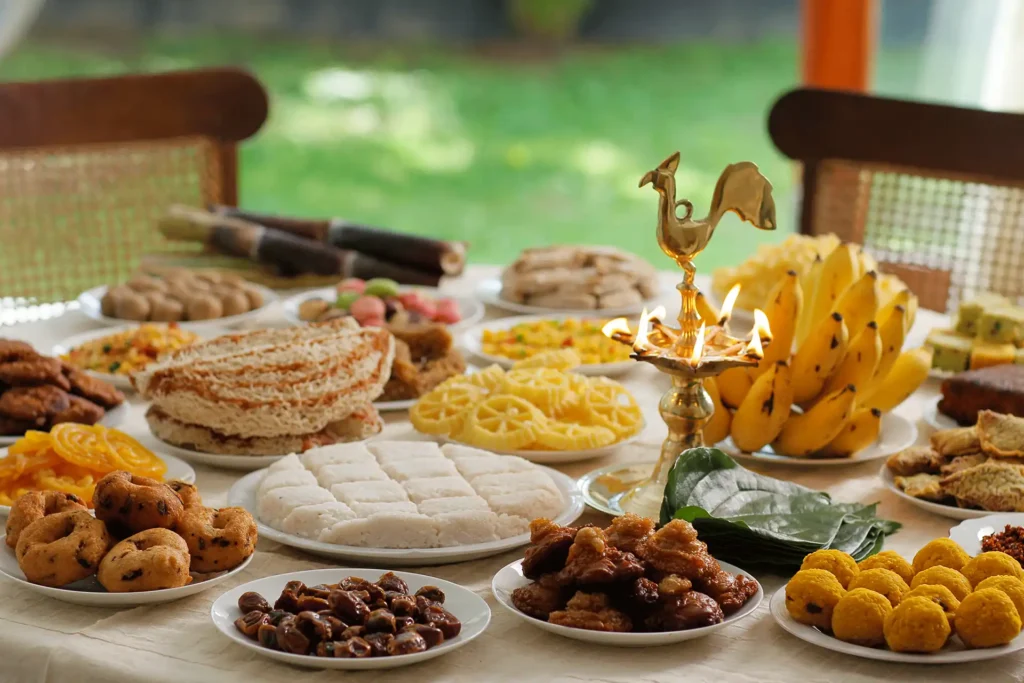
Aluth Avurudu celebrations in Sri Lanka
Now that I have your attention with this mouth-watering spread of Aluth Avurudu Meals, let’s dig into the details about the Aluth Avurudu Celebrations in Sri Lanka – also known as the Sinhala & Tamil New Year. For a Sri Lankan or a person who has experienced the Aluth Avurudu in Sri Lanka, whereever you go in Sri Lanka, the air buzzing with the fireworks, crackers, the scent of milk rice, men wearing sarong and ladies in either Sarees or or the Redda-Hatte is not so uncommon. To the Sri Lankans, Aluth Avurudu is not just another date in the calendar; it’s a Feeling. The Aluth Avurudu celebration feeling.

Table of Contents
Is Avurudu celebrated Only in Sri Lanka?
Yes & No. You see, the Aluth Avurudu is a deep-rooted Astrological tradition. You can actually re-phrase that to related to Harvesting and Agriculture too. The timing for the Aluth Avurudu is based on the sun’s transition from the Meena Rashiya (House of Pisces) to the Mesha Rashiya (House of Aries); according to the Hindu astrological calendar. This marks the end of the harvest season and the beginning of spring season.

The concept of a solar new year in April is shared by numerous cultures across South and Southeast Asia:
- India: Regions like Assam (Rongali Bihu), West Bengal (Pohela Boishakh), Kerala (Vishu), and Punjab (Vaisakhi) celebrate analogous festivals.
- Thailand: Songkran
- Cambodia: Chol Chnam Thmey
- Laos: Pi Mai
- Myanmar: Thingyan
Each of these festivals carries unique cultural imprints but shares the common theme of renewal and gratitude.
Origins of the Aluth Avurudu celebrations
In ancient times, the New Year was celebrated as “Aluth Sahal Mangalle” (අලුත් සහල් මංගල්ලේ) – literal translation to “New Rice Harvest Ceremony” – a harvest festival. Communities gathered to thank the gods for a bountiful harvest and seek blessings for the upcoming planting season. The festival revolved around the first rice meal of the new harvest, symbolizing prosperity and abundance.
Over time, Aluth Sahal Mangalle evolved into the vibrant Avurudu we know today. The fusion of Sinhalese and Tamil customs created a unique celebration that transcends ethnic boundaries.
It’s all about the Timing & the Stars!
Aluth Avurudu is about the timing and the stars. Forget just watching a calendar! Sri Lankans follow ‘Nekath’ (නැකත්) auspicious times calculated by astrologers. Everything from cooking the first meal to starting new work happens at these precise moments. Curious? Keep reading – more details follows.
In 2024, the Sri Lanka’s astrologers are divided into the publishing of the Avurudu Nekath (Auspicious times) because of two groups of astrologers. So, this whole Auspicious times became a whole lot confusing for many Sri Lankans in 2024 Avurudu season.
2024 Aluth Avurudu Nekath (Litha – ලිත)
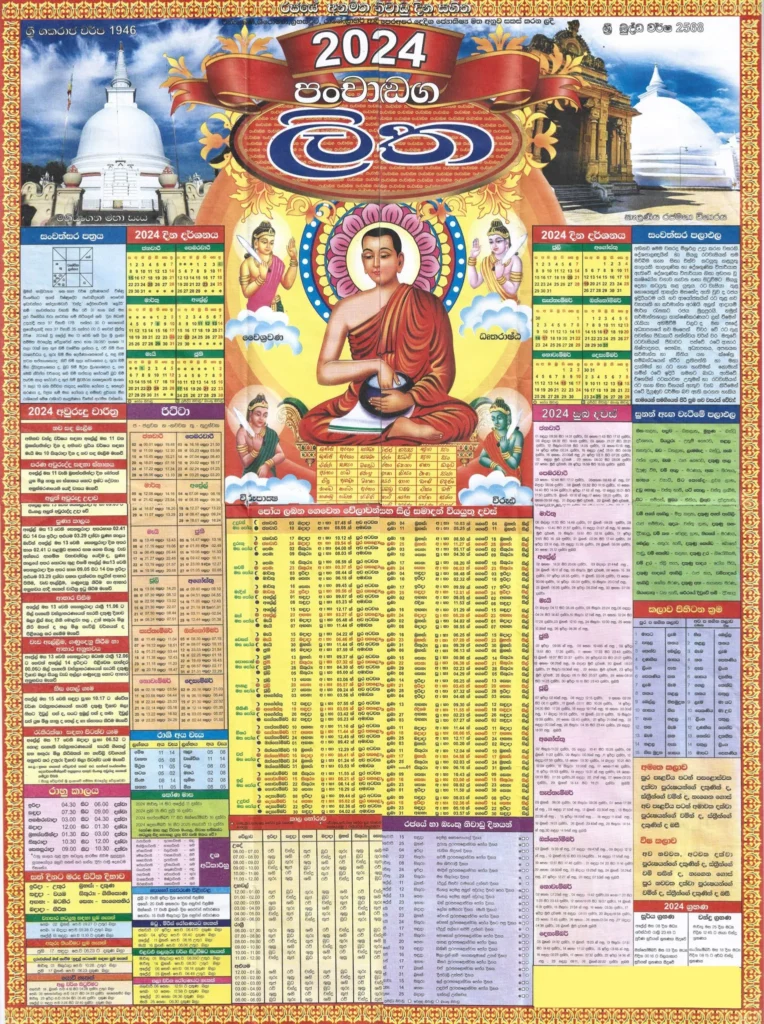
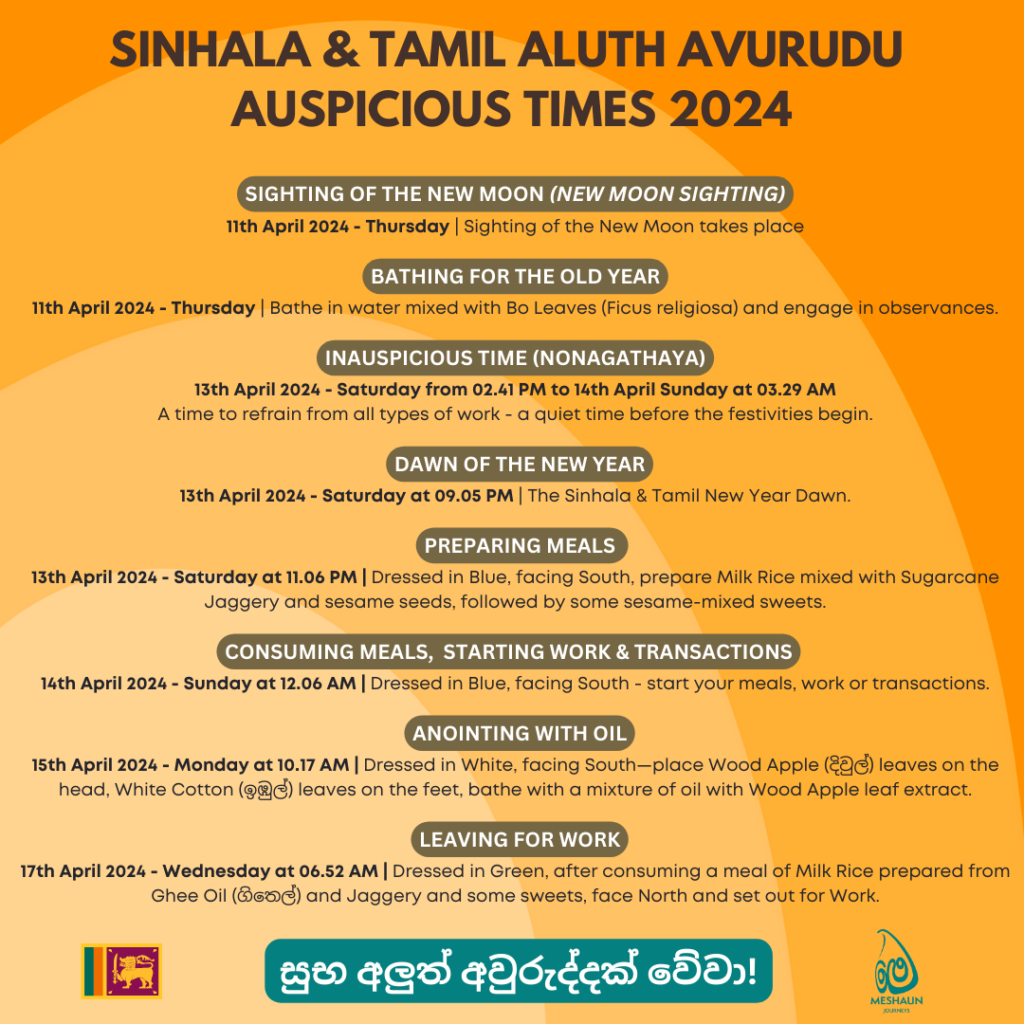
There are many activities followed using the Aluth Avurudu Litha – or the list of Auspicious timings.
| Activity | Meaning / tradition |
| Bathing for the Old Year (Parana Avurudda) | Bathing on the last day of the old year, with water infused with herbs and flowers, is a purification ritual that signifies washing away the old year’s ills and sorrows to enter the new year refreshed and cleansed. This usually involves the use of specific leaves and roots, believed to have medicinal and auspicious properties. |
| Dawn of the New Year (Aluth Avurudda) | This moment signifies the transition from the old to the new year, marked by specific astrological calculations. |
| Punya Kaalaya (Nonagathaya or Inauspicious Time): | This period is meant for reflection and refraining from all types of work, focusing instead on religious activities and family. It’s a quiet time before the flurry of festive activities begins |
| Lighting the hearth | The lighting of the hearth for the first-time after the dawn of the Aluth Avurudda (New Year) is considered a time of prosperity and good-luck. |
| Preparing and consuming Kiribath (Milk Rice) | Sharing the first meal of the year is deeply symbolic. Its richness represents abundance and togetherness. |
| Commencing of Work and Transactions | Starting a task at the designated auspicious time sets an intention for productivity and success throughout the year. |
| Anointing with Oil | A ritual done by elders where oil is applied to the head of younger family members, symbolizing blessings for health and wellbeing. |
| Leaving for Work | There’s a designated time for departing for your job, meant to promote success and smooth transitions. |

Some other traditions and activities celebrated during the Aluth Avurudu times are:
- Wearing specific colors: Certain colors are considered auspicious for the New Year and may influence clothing choices.
- Offering Betal leaves: Offering betel leaves to parents and elders is a sign of respect and seeks blessings from them. It’s a gesture that strengthens familial bonds and honors the elders in the family.
- Engaging in traditional games: A variety of traditional games, such as pillow fights (Kotta Pora), sack races, and climbing the greasy pole (Lissana Gaha), are played, fostering community spirit and fun. Sometimes people get together and form a Avurudu Kreeda Uthsawa (New Year Game events) to make it more colorful.
- Planting Tree saplings: Symbolizing growth and environmental consciousness, this tradition encourages participants to plant a tree sapling, reflecting hopes for a sustainable and prosperous future.
- Sharing Avurudu sweets and meals with neighbors and relatives: People tend to visit their neighbors and relatives with their home-cooked Avurudu meals and share these foods. Sometimes kids visit their parents, mostly a get together in the ancestral home to celebrate the unity and rekindle friendships.
Aluth Avurudu Sweets & Meals:
There are many traditional sweets and meals made during the Aluth Avurudu season. True, some city-area homes now tend to buy these from the shops because of the difficulty in making these traditional meals but the essence stays the same.

Konda Kevum: A deep-fried oil cake with a distinct shape, flavored with treacle and sugar, and made primarily from rice flour.
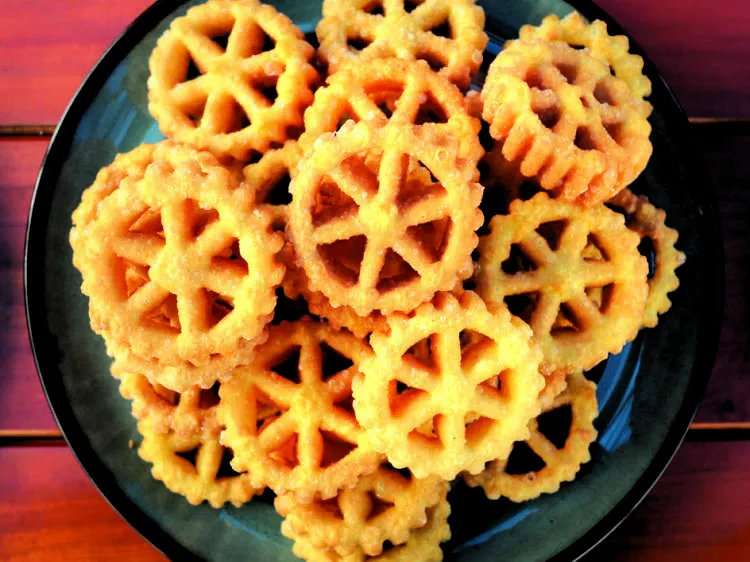
Kokis: A crispy and sometimes sweet snack made from a batter of rice flour and coconut milk, deep-fried to achieve a delightful crunch.
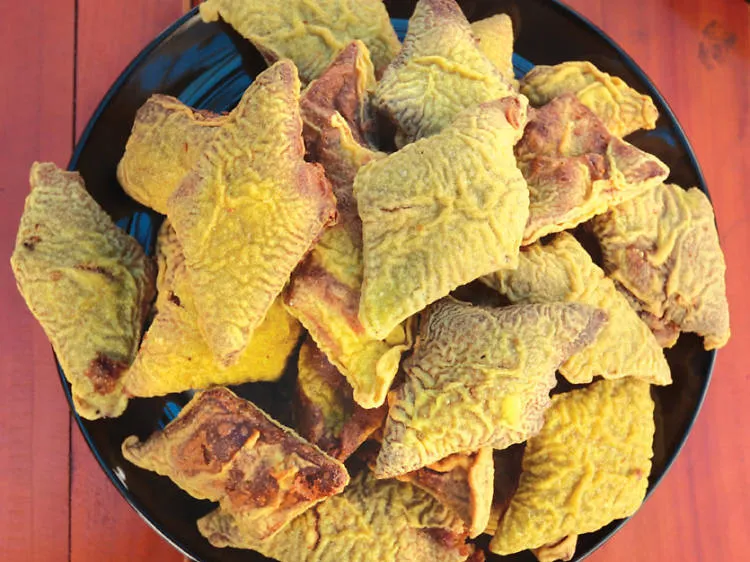
Mung Kevum: A sweet made by combining rice flour and green gram flour with treacle, shaped into diamonds, coated in batter, and deep-fried.

Asmi: A lacy, fried sweet made from a rice flour batter, known for its intricate web-like design and sugary coating.
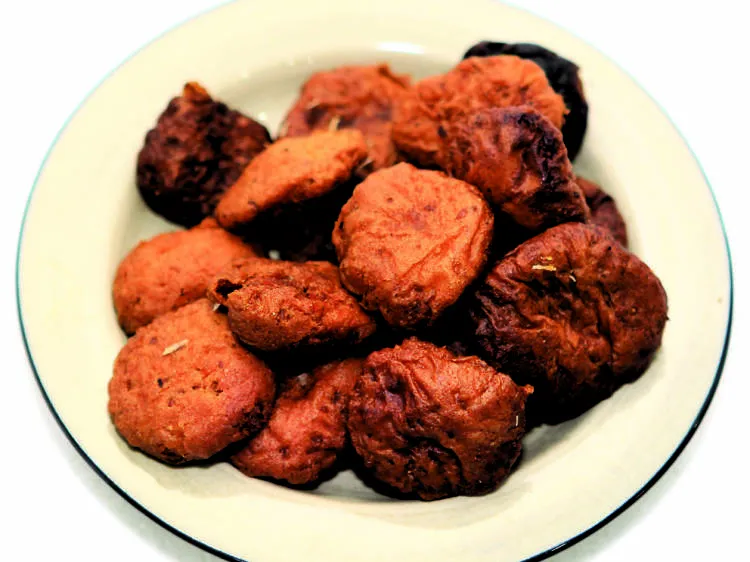
Athirasa: A type of oil cake made with rice flour and jaggery, known for its rich sweetness and circular shape.
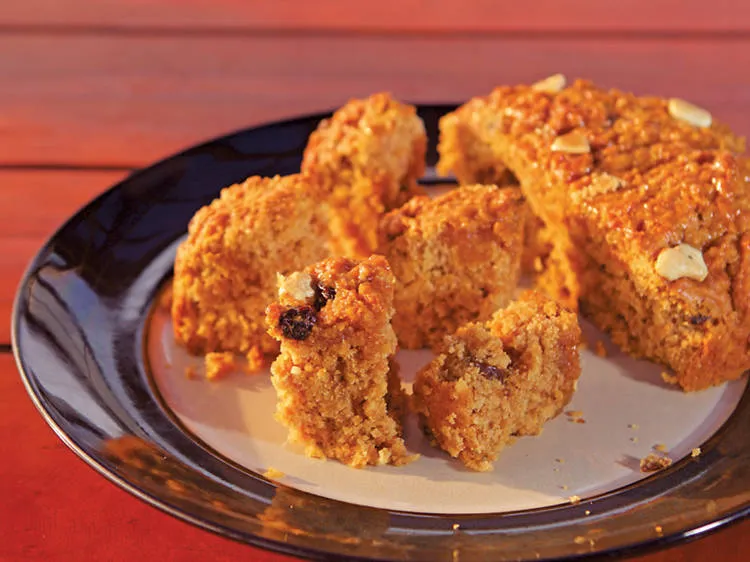
Bibikkan: A moist and dark cake made from coconut, jaggery, and a mix of spices, embodying the rich flavors of Sri Lankan cuisine

Aluwa: A simple yet delightful sweet made primarily from rice flour and treacle, formed into diamond shapes
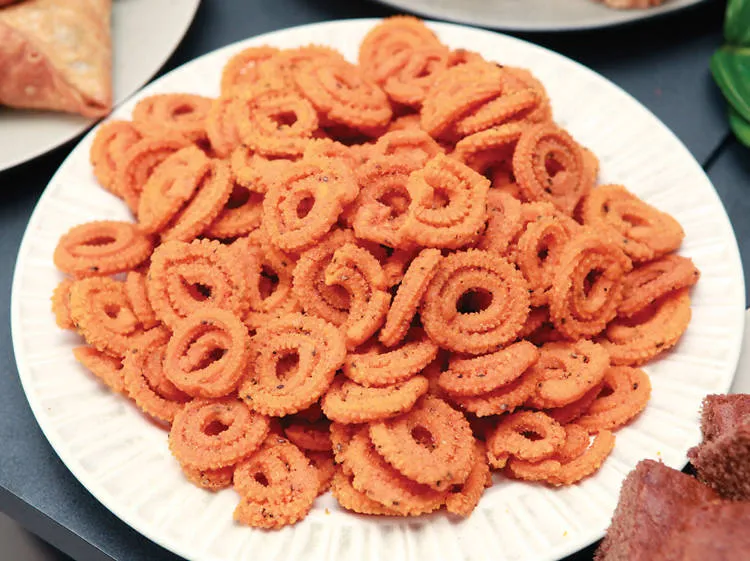
Murukku: A versatile snack that can be savory or sweet, made from various flours and shaped into coils or twists
As a tourist, where can I see this Aluth Avurudu?
That’s a good question. Sure, Sri Lanka as a whole country celebrates Aluth Avurudu.
But as a tourist?
You can join almost any Avurudu celebration throughout the country. There is no restriction. Sri Lankan’s being one of the most-friendliest, would definitely love seeing you joining the celebrations too. Maybe you can even dress local with the sarongs or the sarees.
When you pick a hotel to stay, most hotels will have their own Aluth Avurudu celebrations. It might not be based on the exact timings because some clients might not be interested to take part in them but events like the Avurudu Games, Avurudu meals, drummings, crackers can be enjoyed while staying in these hotels.
Want a Aluth Avurudu-based Sri Lanka travel plan?

Connect with MESHAUN Journeys for the next-holiday in Sri Lanka with a focus on the Aluth Avurudu celebrations. We have experts who will make sure you enjoy the Sinhala & Tamil New Year (Aluth Avurudu) like a Sri Lankan and get this experience while in Sri Lanka. Simply WhatsApp/Message/Email or DM us or set an appointment via the Consultancy so we can help you with your Sri Lanka travel planning.
